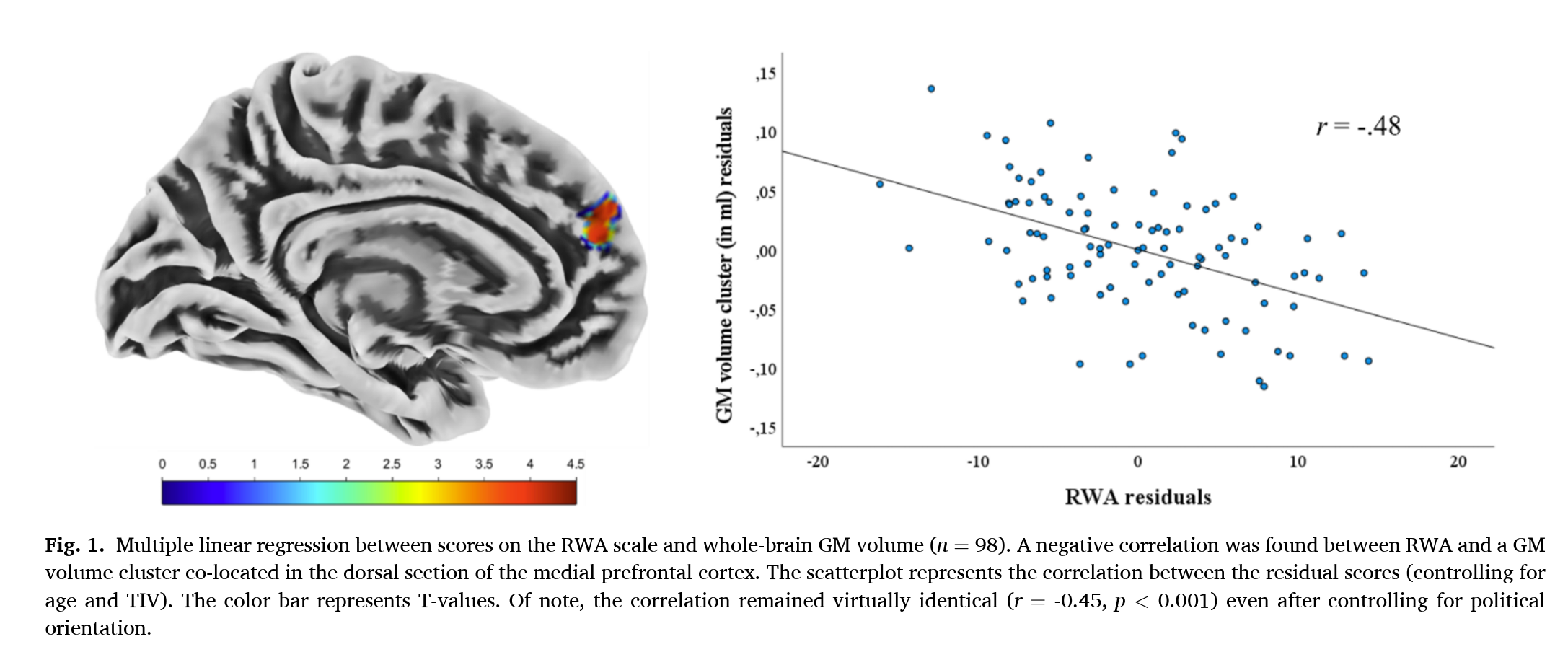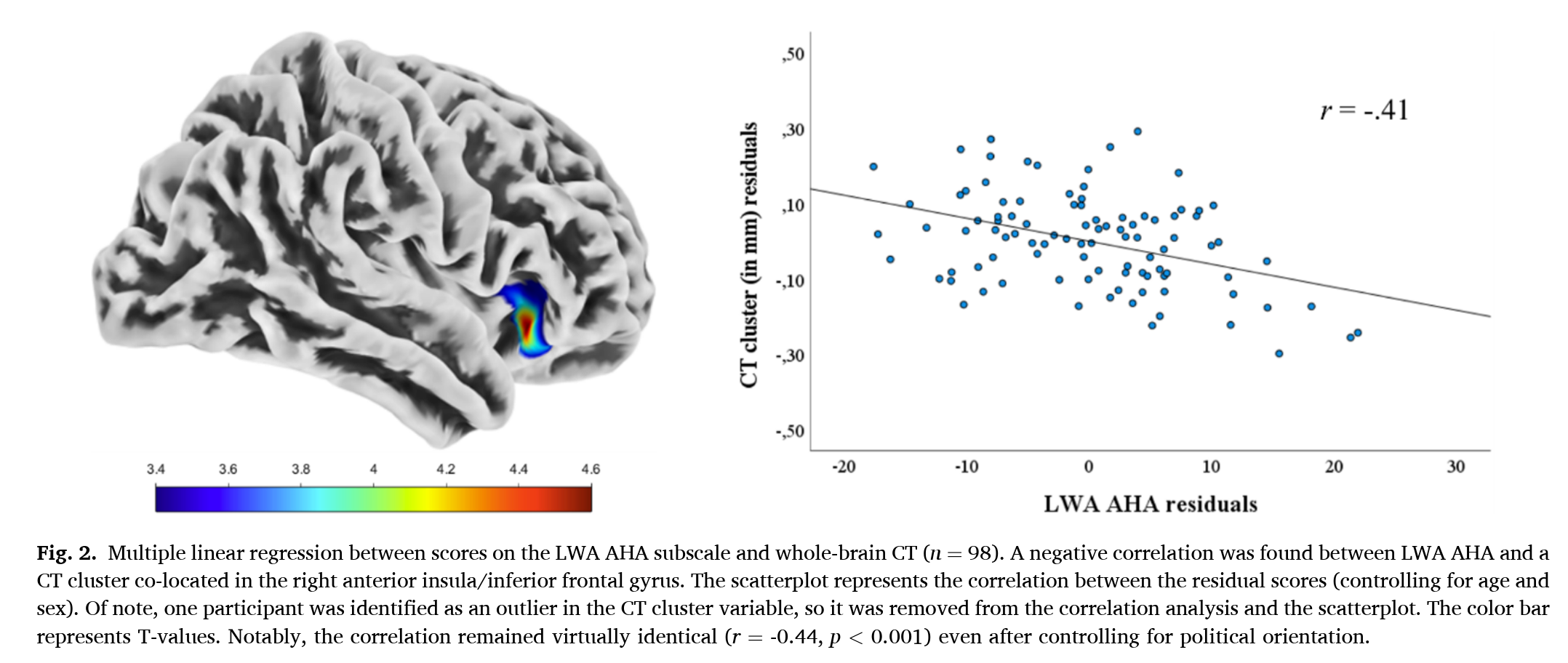Neuropolitics news
« previous post | next post »
"Authoritarian attitudes linked to altered brain anatomy, neuroscientists reveal", PsyPost 4/19/2025:
A new brain imaging study published in the journal Neuroscience has found that authoritarian attitudes on both the political left and right are linked to specific structural differences in the brain. Young adults who scored higher on right-wing authoritarianism had less gray matter volume in the dorsomedial prefrontal cortex, a region involved in social reasoning. Meanwhile, those who endorsed more extreme forms of left-wing authoritarianism showed reduced cortical thickness in the right anterior insula, a brain area tied to empathy and emotion regulation.
The research aimed to better understand the brain-based traits that might underlie authoritarian thinking. Previous studies have documented the psychological characteristics associated with authoritarianism—such as impulsivity, dogmatism, and heightened sensitivity to threat—but few have examined whether these traits are reflected in brain structure.
The cited paper is Jésus Adrián-Ventura et al., "Authoritarianism and the brain: Structural MR correlates associated with polarized left- and right-wing ideology traits", IBRO Neuroscience 5/24/2025.
Scientific publications that correlate behavioral and biological traits are generally good for mass media click-bait. This includes "gene for X" theories, Neuropolitics, and connections between behaviorally-defined disorders and neuroanatomical differences (see e.g. here).
And this new study, as usual, offers yet another lesson in grouping-think. The cited paper's findings about neuroanatomical connections to sociopolitical attitudes are fairly weak, and do not show categorical splits. To start with:
Results from the ROI analysis only revealed weak associations (Table 4). In particular, we observed a significant negative association between the vmPFC GM volume and the LWA AC subscale (r =-0.18). Likewise, results revealed a significant negative correlation between the LWA AHA and the vmPFC CT (r =-0.18). Although significant, these results yielded low effect sizes so their interpretation should be taken cautiously.
[ROI is "Region Of Interest", vmPFC is "ventro-medial PreFrontal Cortex", GM is "Gray Matter", CT is "Cortical Thickness". LWA is "Left Wing Authoritarianism", AC is "Anti Conventionalism", AHA is "Anti Hierarchical Aggression".]
They were able to get somewhat higher correlations for the residuals in some corners of a multivariate model of brain regions and sociopolitical dimensions, e.g.
and
There's a possible concern about "data dredging", given the exploration of different aspects (gray matter volume, cortical thickness) of many specific brain regions, in relation to multiple dimensions of their sociopolitical survey. There's also the step from correlating individual neuroanatomical and psychosocial features, to correlating the residuals of those features in a multivariate statistical model. The "data dredging" concern would be alleviated if they designed the experiment to test a limited set of hypotheses framed in advance. There's an explicit description of such hypotheses with respect to the (negative or weak) ROI analyses presented in Table 4, but not so much for the analysis of multivariate residuals, as far as I could understand.
In any case, the results don't support the view that people fall into well-separated psychosocial natural kinds (here authoritarian/non-
Speculations about "neuropolitics" have been around for a while — a small taste of slightly earlier stuff in the media:
"Conservative and Liberal Brains Might Have Some Real Differences", Scientific American 10/26/2020
"Your brain can reveal if you’re rightwing – plus three other things it tells us about your politics", The Conversation 3/22/2025
But this new study provided journalists with some seriously impressive clickbait, e.g. "Scientists scanned the brains of authoritarians and found something weird", Futurism 4/27/2025:
People who support authoritarianism on either side of the political divide have, according to a new study, something weird going on with their brains.
Published in the journal Neuroscience, new research out of Spain's University of Zaragoza found, upon scanning the brains of 100 young adults, that those who hold authoritarian beliefs had major differences in brain areas associated with social reasoning and emotional regulation from subjects whose politics hewed more to the center.
[Note: I've updated the post after reading the paper more carefully.]



Robert Coren said,
May 1, 2025 @ 9:07 am
Yeah, my skepticism-antenna responded emphatically to that abstract.
Gokul Madhavan said,
May 1, 2025 @ 9:49 am
Any suitable coinages for this sort of behavior? Neurophrenology, perhaps?
Mark Liberman said,
May 1, 2025 @ 11:51 am
@Gokul Madhavan:
"Neurophrenology" is Out There —
J.W. Brewer said,
May 1, 2025 @ 2:54 pm
The "connections between behaviorally-defined disorders and neuroanatomical differences" thing here is magnified/amplified by the "pathologizing/medicalizing your political adversaries" thing, and thereby transmuting "a set of political views I find foolish, obnoxious, or wicked" into a behaviorally-defined disorder.
All we need now is a sociobiology Just So Story about why "authoritarian" views could have provided a reproductive advantage in some parts, but apparently not other parts, of the prehistoric African savanna.
david said,
May 1, 2025 @ 4:01 pm
There are two scatter plots in the paper with r = 0.45 and 0.41 to support the claims for each group. Not very compelling evidence.
Toby Colin Blyth said,
May 1, 2025 @ 11:20 pm
Coincidentally these sorts of studies all tend to point in one political direction…
Mark Liberman said,
May 2, 2025 @ 4:49 am
@David: "There are two scatter plots in the paper with r = 0.45 and 0.41 to support the claims for each group. Not very compelling evidence."
Thanks. I've updated the paper to include those plots, which emerge from selected residuals in a statistical model relating many neuroanatomical and psychopolitical features.
Linda Seebach said,
May 2, 2025 @ 9:00 am
If there is a link, even a weak one, how do we know which way the causality runs?
The anatomy of the brain des, to some extent, reflect what the brain's owner spends time thinking about (e.g., London cabbies).
Mark Liberman said,
May 2, 2025 @ 6:16 pm
@Linda Seebach: "If there is a link, even a weak one, how do we know which way the causality runs?"
Indeed — neuroanatomical differences could influence sociopolitical attitude differences, or vice versa. But there also could be a completely separate covariate influencing both, like differences in ethnic background or child-rearing practices or whatever.
Philip Anderson said,
May 3, 2025 @ 5:00 am
Even if there were a difference between the brains of two groups, it’s interesting that the “authoritarian” type is labelled “weird”, but not the other. To many of the former, “liberalism” is the aberration, with words like “woke” (and before that “politically correct”) used as terms of abuse.
The kind of extremism that wants to exterminate those who disagree may be sociopathic, but it seems normal that society includes a range of opinion. And people’s views change over time and as circumstances change; perhaps their brains change too, but that is inverse causation. Traditionally, people became more conservative with age (which is not necessarily authoritarian), but I think that is less true now (at least in the UK).
Jacob Stewart said,
May 4, 2025 @ 2:14 pm
@ Philip Anderson
I, and many others, would argue that some aspects of "woke" and "political correctness" are a form of left-wing authoritarianism. Particularly when it comes to language use.
Jonathan Smith said,
May 4, 2025 @ 8:53 pm
Jake, Jake. It's over buddy. You're fine; that was a RedHot. Let's go home, grab you some warm milk and a shower. […] Yeah, the colored people are still in your Star Wars. We'll figure it out man. *throws arm around Jake's shoulder*
David Marjanović said,
May 5, 2025 @ 7:41 am
I think that was never true. Rather, throughout the 20th century, old people were on average more conservative than young people in any given year as each new generation was, and stayed for its lifetime, to the left of the preceding one.
What there is evidence for is people who start out as conservatives slowly but steadily drifting to the left over decades. Known examples include a long list of US Supreme Court justices and my mother.
Daniel Barkalow said,
May 7, 2025 @ 4:45 pm
My immediate reaction was: "What can this tell us about the political inclinations of post-mortem Atlantic Salmon?" I hear their interspecies perspective-taking has been studied in a very insightful and relevant way.